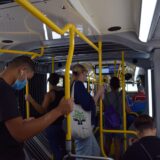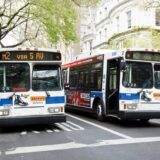COVID-19 is highly transmissible in enclosed spaces. Given the crowded nature of public transportation, authorities have had to either shut down or limit bus, train, and shuttle services in an effort to minimize the rate of infection. Some people also took to driving their own cars or riding bikes or motorcycles to avoid public transportation. But as lockdowns ease and vaccination rates increase, can public transit regain ridership?
Many experts agree that yes—ridership will increase again. To ensure everyone’s safety, operators need to invest in modern passenger information systems in addition to encouraging the observance of health and safety protocols.
 Embrace digital transformation
Embrace digital transformation
The public transit industry must take steps to provide safer and more convenient rides to survive the pandemic and post-pandemic era. Even as the economy reopens, minimum health protocols such as mask requirements, contactless transactions, and social distancing will likely continue, especially in large cities. Many commuters will remain apprehensive about getting exposed to the virus when they take the bus or ride the train. The numbers certainly show this trend. According to Streetlight Data and the MTA, ridership in the New York City subway has not increased as rapidly as car traffic. While it’s up by 32 percent, car traffic is up by 58 percent.
Public transit authorities need to think of ways to encourage people to move safely and increase their confidence during their commute. Services and technologies such as the next stop announcement system and digital transit sign can help make a difference in helping commuters navigate and plan their trips accordingly. Smart technologies and intelligent passenger sign systems can also help transit companies adapt to the new normal as the world continues to recover from the pandemic.
 Enable trip planning
Enable trip planning
Trip planning apps are becoming smarter and better at helping riders make informed decisions on their daily commutes. There have been a lot of developments in this field. In New Zealand, for example, there is an app that logs data as riders tap their transit cards to get on or off the bus. The app then uses this data to determine the number of available seats on any given bus.
Such developments in passenger information systems can help male commutes safer by allowing passengers to plan their trips accordingly. Riders can quickly determine which routes are available ahead of time, so they know when and where to board and potentially avoid an overcrowded commute.
 Enhance communication
Enhance communication
Voice announcement systems can encourage successful and timely communication, which is crucial to reduce the risk of spreading the virus while improving ridership. Such a system can be used to remind passengers to observe social distancing guidelines. It can also be used to let riders know that the bus is regularly sanitized to make them feel safer. Voice announcement systems are useful in providing immediate information on changes in services and disruptions, too.
Riders shouldn’t be expected to visit the transit company’s website for announcements and advisories. The information should be communicated to them in real-time. A next stop announcement system can help with that.
Smart technologies can push announcements to passenger phones, too. These solutions also let drivers and managers stay constantly in touch for updates, monitoring of incidents or cases, and seamless coordination.
 Use GPS creatively
Use GPS creatively
Modern passenger information systems come with next-generation GPS systems with updated features and better functionality. Previous GPS technologies were useful only for determining mileage, estimating arrival times, and navigation. Nowadays, they can be helpful in making trip adjustments according to traffic and road conditions, and the weather. This may help transit companies ensure a safer ride.
 Focus on people who still rely on public transportation
Focus on people who still rely on public transportation
Transit companies are becoming more flexible by applying relevant strategies that will help revive ridership. Many people will always rely on public transit to get around. A modern transit sign and voice announcement systems can help transit companies focus on serving the needs of these people to maintain and recover ridership during and well after the pandemic.














